
Identifying Common Florida Lawn Diseases and Treatment
When disease takes over your Florida lawn, it can leave the grass looking damaged, patchy and unhealthy. With all the work you’ve put into maintaining your lawn, this is the last thing you want to happen. To keep disease at bay, it is important to first understand what types of lawn diseases are common in Florida, how to identify them, and how to treat them. Here’s what you need to know about some of the most prevalent.
Dollar Spot
This disease is common among warm-weather grasses, so it is well-suited to the Florida climate. You’ll notice spots throughout your lawn that are about the size of a silver dollar. This is called dollar spot disease. Within these spots, you’ll see lesions on the grass blades. To prevent these, pay close attention to your soil composition. Low nitrogen levels enable dollar spot to thrive, so look for a fertilizer that will maintain nitrogen in your soil. Also, always mow your lawn with sharp blades to prevent damage, and avoid mowing your lawn when it is wet.
Root Rot
Root rot can occur in grasses virtually anywhere in the world, but it is particularly common in Florida due to the wet, humid climate. This disease typically arises when the grass holds too much moisture over too long of a period, and also when there is minimal air circulation. When watering your lawn, try to provide no more than about an inch of water each week. Be sure to take rain into account when setting your watering schedule. Remove any thatch that has formed around the base of your lawn as well, as heavy thatch can inhibit air circulation, essentially choking off your lawn.
Brown Patch Fungus
Most commonly seen in St. Augustine, Fescue and Zoysia grasses, brown patch fungus shows up when the weather is hot, meaning over 85 degrees during the day and over 70 degrees at night. With the warm climate here in Florida, that covers a broad swath of the year, so you’ll need to be constantly vigilant, as this disease is remarkably aggressive. Watch out for brown or tan patches with a darker ring around the border. These patches often start out small but can quickly grow to several feet in diameter. To prevent brown patch fungus, avoid watering your lawn at night, instead watering early in the morning before the sun comes up. Aerate and dethatch your lawn frequently as well to help with air circulation and facilitate evaporation.
Fairy Ring
This is one of the more difficult lawn diseases to get rid of because by the time you notice the signs of it, it has already been infecting your lawn for several years. Even when you think you have gotten rid of it, the disease can come back again in future years. Fairy ring spreads throughout your lawn’s root system, leaving large rings of dark green or brown grass on the surface. These rings typically range between 3 and 20 feet in diameter. In some cases, you may see mushrooms along the edges of the rings, though not always. Because this disease is so insidious, it typically requires a professional to treat to ensure it doesn’t come back year after year.
Rust Fungus
Although not particularly dangerous in and of itself, rust fungus can damage and weaken your lawn, leaving it susceptible to more serious diseases, like those discussed above. This disease often attacks grass in the shade where moisture is more likely to accumulate, typically in spring or fall. Watch out for yellow flecks on the grass blades when the disease is in its early stages. As it progresses, these flecks can rupture, coating your lawn in a yellow or orange sport powder. In late stages, blades turn rust-colored and tend to grow more slowly. They can even begin to die off. Avoid over-watering, and aerate and dethatch often to promote air circulation.
Restore Your Lawn with Professional Treatment and Fresh Sod
If turf disease has damaged your lawn, you can bring it back to health with fresh sod. Sod enables you to fill in any bare patches with new, healthy grass that will be better equipped to fight off diseases. Get in touch with Duda Sod today to learn more about the many types of sod we have for sale in Florida. Your beautiful, healthy lawn awaits!